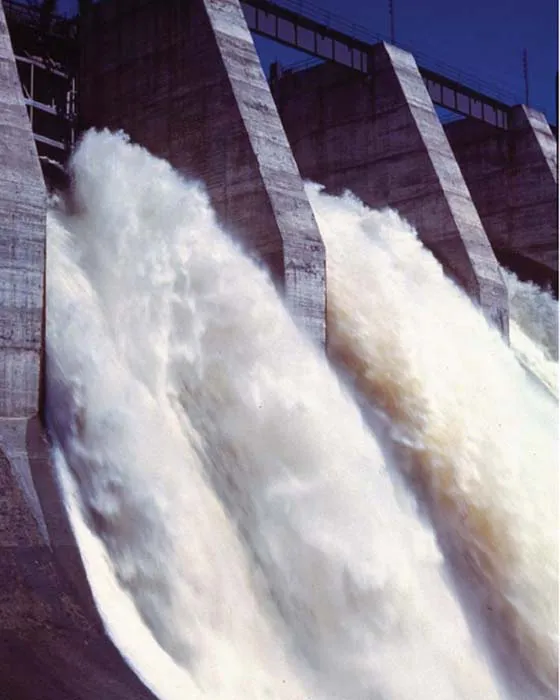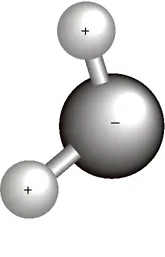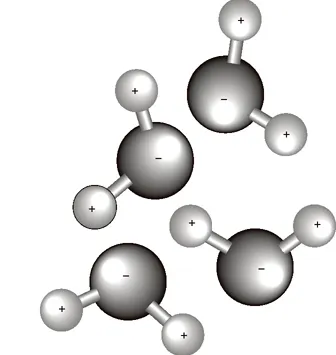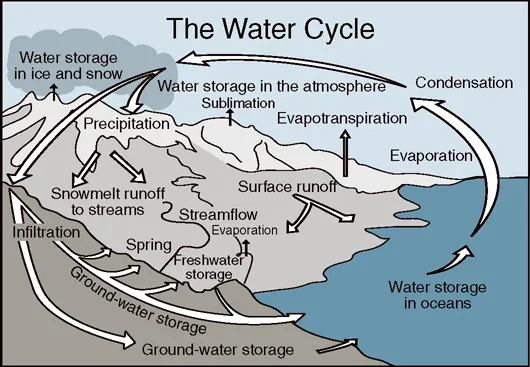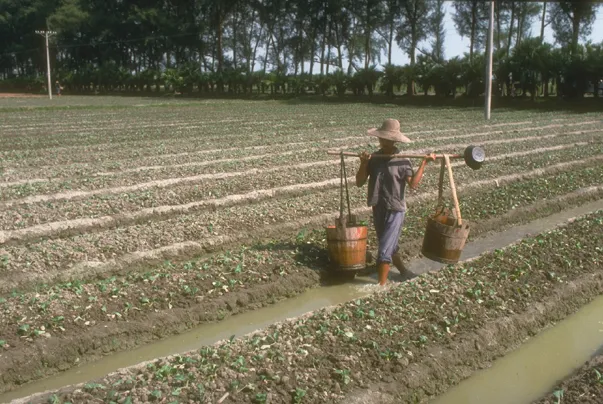![]()
The Canadian Shipshaw Dam generates a substantial amount of hydroelectric power and was built to power the Canadian aluminum industry.
Seventy-one percent of our planet is covered with water, and water is essential to all life on Earth. Water makes up about 60 percent of the human body, which requires at least a half-gallon (2 liters) of water each day to survive. In addition to drinking water, people need water for irrigating crops and transporting people and goods. Human settlements have always centered around sources of water, from desert oases to bustling seaports.
Water is also an important power source. In the early days of industry, water powered mills that sawed lumber and produced cloth. Today, water is used to generate electricity in huge hydroelectric plants where dams have been built across some of the largest rivers in the world.
PROPERTIES OF WATER
Why is water so special? In its most basic form, water is a common liquid with no color or smell. However, water has specific chemical and physical properties that make it different from most other substances on Earth.
Left: A single water molecule consists of one oxygen atom and two hydrogen atoms. Once bonded together to create water, the oxygen portion is negatively charged while the hydrogen portion is positively charged.
Right: Groups of water molecules clustered together can form intricate lattice structures when in the solid form, or are less organized when in the liquid form as shown here.
First is its molecular structure. Water has a very simple chemical formula: one water molecule is made up of two hydrogen atoms that are bound to one oxygen atom. The chemical formula for water is H2O.
Due to the properties of the oxygen atom, the two hydrogen atoms stick to a single side of the oxygen atom, rather than one on each side. The water molecule is therefore not symmetric, and becomes like a magnet: the side with the hydrogen atoms ends up with a negative charge, and the other side has a positive charge.
This chemical structure allows water molecules to stick to one another. The negative side of one water molecule attracts the positive side of another water molecule and this attraction results in clumps of water. This “stickiness” yields high surface tension (the attractive force of molecules on water’s surface), which causes water to hold together in drops.
While most materials can be found only as a solid, a liquid, or a gas at the surface of the Earth, water can exist in all three phases. Water’s three forms are solid ice, liquid water, and gaseous steam.
Water’s physical properties cause it to form a crystal structure when it freezes, and it is one of the only substances on Earth that is actually less dense in a solid state (ice) than it is in a liquid state (water). This varied density explains why ice floats in water. With most other substances the solid form sinks to the bottom of the liquid. For example, if salt crystals form out of a salt solution, the crystals will fall to the bottom of the container rather than float on top.
Water is also sometimes called the “universal solvent” because many substances can be dissolved in it.
THE WATER CYCLE
Water is always in motion. The water cycle describes the movement of water from solid to liquid to gas and the physical movement of water over the surface of the earth. Starting in the clouds, which are made up of tiny drops of water vapor, water eventually reaches a high enough concentration to precipitate out as rain. Under the right conditions, raindrops may freeze into delicate crystalline snowflakes and land on mountaintops or in cold regions. There, water is stored in the form of snow. When summer comes, the snow melts and liquid water runs down from the mountains in streams and rivers or in underground aquifers.
From the potential energy of an ice pack at the top of a mountain, liquid water converts into kinetic energy as it travels downhill. Potential energy is stored energy, and kinetic energy is the energy that results from the motion of a body. The flowing water may eventually reach a large pond or lake, or it may travel all the way to the ocean. Since water is a liquid, it forms an equipotential surface. This means that sea level is approximately the same absolute distance from the center of the earth everywhere on the globe (except for variations due to temperature, pressure, and other factors). Reaching an equipotential surface halts the downward motion of water, which stops when it reaches a stable lake or ocean that is at sea level or has no outlets for water to continue its downward journey Heat energy is transferred to the water by sunlight, which eventually causes some of the water to evaporate. This water vapor ascends into the atmosphere, where it forms clouds and eventually rain, and the water cycle begins again.
This diagram of the water cycle shows how water is stored in the natural environment as ice, snow, and ground water; events such as runoff, evaporation, and condensation complete the circular nature of water’s motion from atmosphere to land to ocean and back to atmosphere.
WATER AND EARLY AGRICULTURE
Early humans were primarily hunters and gatherers who moved around the countryside, traveling to where plants and animals were abundant in different seasons. Eventually they understood that if they planted crops and domesticated animals, they could create a stable food source rather than following game and vegetation as the seasons changed. As more stable societies were formed, the development of agriculture allowed larger groups of people to remain in one place all year round.
Irrigation is an important element of any agricultural society. Forests and grasslands tend to grow naturally and flourish and wither with the seasons. But humans rely on plants for food and cannot be at the mercy of nature. In most areas of the world, but particularly in those that have long hot summers, plants must be watered if they are going to survive and produce food. Early farmers probably planted crops in areas that were naturally wet and lush. As civilizations expanded, the land available for farming was more marginal and often required additional water to be fully productive.
Early irrigation was likely as simple as carrying a bucket or other container of water from a river or spring to where crops were grown. Major agricultural areas required more substantial irrigation to support growing populations. The area of the world located in the Middle East and northern Africa along the Nile, Tigris, Euphrates, and Indus rivers is often called the cradle of civilization because of the early cities that were located there. In regions like Egypt, the only fertile land was near a river. Early settlers could easily increase the amount of arable land by building dams and canals to store and transport water to drier outlying areas.
Farmers along major rivers also took advantage of natural cycles to help support their crops. In the Nile River valley, for example, the river goes through a flood stage approximately once a year. During this period, water flow increases, and sediment transport rises dramatically. The faster flow and higher volume of water during the flooding stage causes dirt and organic material to be picked up by the river and deposited high on the banks of the river.
Traditional irrigation can consist of human-powered watering, seen here as a woman carries water directly to the fields.
LIFE IN THE TROPICS
In tropical parts of the world such as Belize, Bali, and Cambodia, early civilizations were spread out rather than being concentrated around major rivers. Tropical parts of the world have large seasonal variations in rainfall, which produce wet and dry seasons rather than the familiar hot and cold seasons experienced in more temperate parts of the world. One of the main issues for people living in tropical regions is water storage during the dry season. Some early tropical civilizations, such as the Maya, built reservoirs on hilltops to capture rainwater from the wet season and save it for use during the dry season. These reservoirs and other ways of saving water for the dry months produced a tropical concentration of civilizations that was decentralized, resulting in more small settlements and fewer large cities than found in semi-arid regions that depended on rivers.
While river floods can be disastrous for permanent cities built near rivers, in ancient times they were recognized as a beneficial part of a river’s cycle. The flood stage deposited fresh, rich dirt full of nutrients. This richer soil helped nourish the next season’s crops as a kind of natural fertilizer. In Egypt, this annual flood was called the gift of the Nile.
TRANSPORTATION
As civilizations grew in complexity, the way they used water began to change. The transportation goods rapidly grew in importance as trade increased and became more specialized. Spices from Asia could be traded for furs from North America, for example, or for gold jewelry from South America.
Raw materials such as lumber also had to be transported. Early traders had only two methods of transport available: over land on animals or over water on boats. Boats can carry larger loads and travel much faster than pack animals, so transporting goods on water is more efficient even if the actual distance traveled is longer. For instance, in the eighteenth and nineteenth centuries in the United States, before the Panama Canal and the intercontinental railroad were built, it was often cheaper and faster to send something by boat all the way down around the southern tip of South America than it was to send it by land from the East Coast to the West Coast!
One of the most cost-effective means of transporting lumber is to float it downstream. Logs are tied together in batches and are guided along their path as necessary.
Transportation of goods and passengers by water was a huge industry Its economic importance was a major reason that large cities often developed in favorable ports, such as New York and San Francisco. Many port cities were also established on major rivers. Raw materials such as lumber could easily be floated down rivers on barges to sawmills and other industrial destinations.
Even today, although airplanes can travel around the globe in a matter of hours, it is very expensive for ...

